A lucky find
This 1966 V35 Bonanza was a buyer’s dream
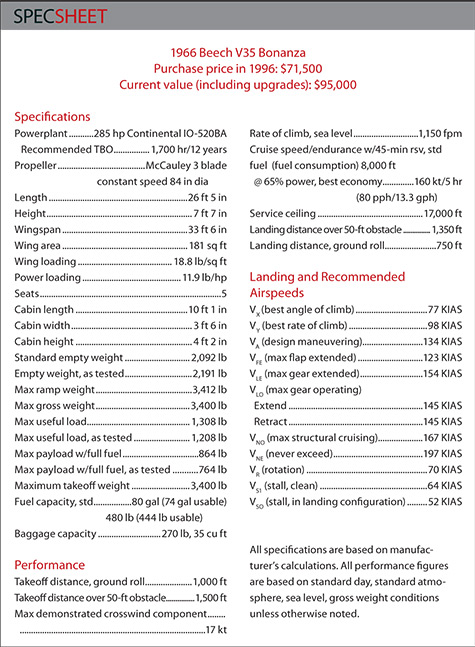
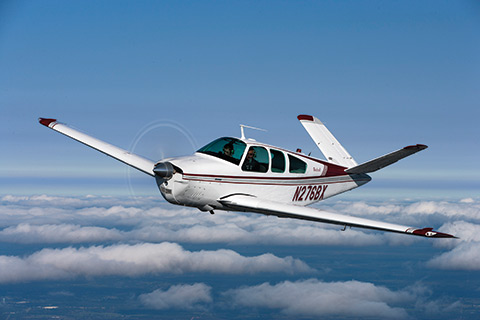
Photography by Mike Fizer
If Pat Smith’s V-tail Bonanza were to be purchased today in the same condition it was in 1996 when he bought it, it would have a base price of $85,000, according to a Vref estimate, but back then it cost $71,500; it had been newly refurbished by one of the nation’s busiest Bonanza repair shops. There was new paint, a new interior, an engine overhaul by another company, and a rebuilt nose gear because of an accident in the Dallas area. Smith was in the right place at the right time, and that place was his own rural Oklahoma neighborhood.
Smith has since added $53,000 in improvements, yet he might get much of his money back, including the purchase price, should he decide to sell it someday. For some unexplained reason the paint and interior still look as they did in 1996 when they were done by the original restoration shop—Biggs Aircraft of Wellston, Oklahoma, located about a 1.5-hour drive east of Oklahoma City.
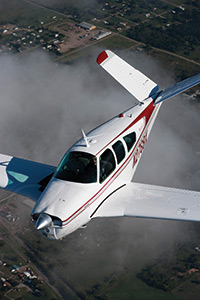 Smith lucked into the Bonanza, and his story gives hope to other potential aircraft owners willing to exercise patience and wait for the right deal. But a caution: Glenn Biggs advises that in today’s market it will take an amazing amount of patience—if it can be done at all. Originally, Biggs purchased the aircraft following a nose gear failure in Texas by a check-hauling company, and intended to keep it for himself. Instead, he sold it to Smith in nearby Chandler, Oklahoma, as a 30-year-old aircraft in perfect condition that delivered 165 knots TAS with no serious maintenance worries for years to come.
Smith lucked into the Bonanza, and his story gives hope to other potential aircraft owners willing to exercise patience and wait for the right deal. But a caution: Glenn Biggs advises that in today’s market it will take an amazing amount of patience—if it can be done at all. Originally, Biggs purchased the aircraft following a nose gear failure in Texas by a check-hauling company, and intended to keep it for himself. Instead, he sold it to Smith in nearby Chandler, Oklahoma, as a 30-year-old aircraft in perfect condition that delivered 165 knots TAS with no serious maintenance worries for years to come.
Smith flies mostly at 8,000 feet using a power setting of 21 inches (full throttle) at 2,300 rpm, and burns slightly more than 13 gallons an hour. He can keep that up for 770 nm before refueling. Smith calculates his per-hour operating cost at $138.96, flying 60 hours per year. He does not keep an engine or avionics reserve fund. Here is the yearly breakdown of expenses: fuel, $4,009; hangar, $1,200 (he owns his own hangar but for this article calculated a hangar rental based on the $100-per-month rates at Cushing Municipal Airport 20 miles from his home); insurance, $1,488; maintenance and annual inspection last year, $1,500; and, oil and filters, $139.50.
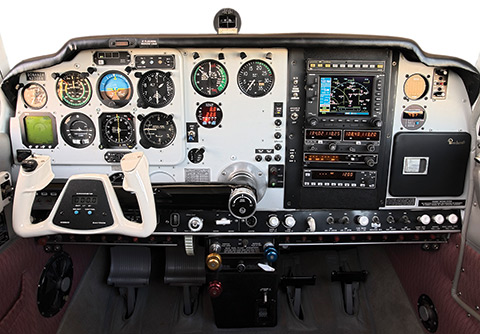
About a third of the $53,000 upgrade total came from the $12,500 Garmin GNS 530 with its $4,000 Garmin GDL 69 datalink with XM weather. (After this article was written, Smith installed a Garmin 496 with a weather datalink. It uses a bracket attached to the center control column. He also uses the same 496 when he takes long trips on his motorcycle.)
Smith began adding improvements to his aircraft shortly after he bought it, but there were no big-ticket items until 1999. After all, he didn’t really need to do anything to it. What follows is a list of most of the improvements, but note these are late 1990s prices; all prices include labor. The less expensive improvements include a Precise Flight standby vacuum system ($681), a Beryl D’Shannon Aviation Specialties air-oil separator ($396), GAMIjectors fuel injectors ($791), and a Northern Airborne Technology intercom ($275). The more expensive additions include a B&C Specialty Products standby alternator ($3,193), a BFGoodrich WX900 Stormscope ($3,500), an S-Tec ST-180 HSI slaved compass system with gyro ($8,000), and an S-Tec System Fifty-Five autopilot with directional gyro, electric trim, and auto trim ($15,600).
A key feature noticed during preflight is the V35’s huge cargo door, 39 inches wide and 23 inches in height—big enough to handle a seriously overloaded suitcase. The main difference in the cockpit for most pilots is the single, throw-over yoke. Instructor and former publisher of Oklahoma Aviator, Earl Downs, frequently flies the aircraft with Smith and gave me a briefing on the use of the yoke and the aircraft panel.
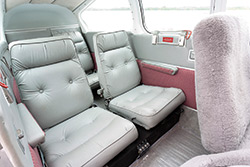 A demonstration flight revealed a well-rigged airplane that continued straight, hands off, as originally intended by Biggs. Rigging is one of the key points Biggs looks for in aircraft he is repairing. In the 1970s and early 1980s, he bought and restored Cessnas, but the market soured and he switched to Bonanzas; today, he focuses mostly on insurance repair work but still offers an occasional refurbished aircraft.
A demonstration flight revealed a well-rigged airplane that continued straight, hands off, as originally intended by Biggs. Rigging is one of the key points Biggs looks for in aircraft he is repairing. In the 1970s and early 1980s, he bought and restored Cessnas, but the market soured and he switched to Bonanzas; today, he focuses mostly on insurance repair work but still offers an occasional refurbished aircraft.
The flight showed a 163-knot TAS at 5,500 feet in smooth air, at the owner’s preferred power setting of 23 inches of manifold pressure and 2,300 rpm. The aircraft also had the tail wagging common in turbulence even in the A36 Bonanzas, something that can be cured with an automatic yaw damper. Stalls proved that the aircraft is well behaved, as expected.
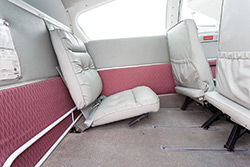 Smith had gone to Biggs before he knew N276BX was available because he wanted advice on how to buy an airplane. “I asked him what to avoid and what to look for,” Smith recalled. I asked Biggs the same question. The information is detailed, but keep this on file in case you are interested in a Bonanza.
Smith had gone to Biggs before he knew N276BX was available because he wanted advice on how to buy an airplane. “I asked him what to avoid and what to look for,” Smith recalled. I asked Biggs the same question. The information is detailed, but keep this on file in case you are interested in a Bonanza.
“The elevators and ruddervators of Bonanzas have magnesium skins and are subject to corrosion,” Biggs said. “Next, you have to watch bolts, bearings, bushings, and hinges in the nose gear, the nosewheel steering mechanism, and the cowl flap. They’ll wear out about every 400 hours. Also check nose gear door retract rods and rod ends for looseness.
“To stress the importance of the pre-buy inspection, the aircraft may have had damage and unairworthy repairs. The facility performing the prebuy inspection should specialize in Bonanza repairs. Just because the logbook does not show damage, it does not mean the aircraft has not had damage. Anything less than a complete and thorough annual inspection is not a good prebuy inspection. We have recently found several Bonanzas with logbooks showing no damage history, but the aircraft were found to have damage. If the price is too good to believe, there is probably something wrong.
“You should also look at the cabin door hinges and pull the door up and down to see if there is any slack. In the landing gear, you’ll need to check—or ask your mechanic to check—the uplock cable tension, up-clearances, and downlock tensions,” Biggs said. (The landing gear system is an electric motor using push-pull rods; however, there is an uplock cable for the left and right main gears).
The key items to look for in any aircraft purchase, Smith noted, are structure, engine, interior, panel, and paint.
Here are some interesting historical tidbits about the Bonanza line. The 1964 S35 interior cabin was lengthened 19 inches compared to previous models. This resulted in a larger baggage area; the maximum gross weight was increased as well that year by 175 pounds to 3,300 pounds; an alternator had replaced the generator; and the 285-horsepower Continental IO-520 engine replaced the 260-horsepower IO-470N. The V35, the one that Smith owns, followed the S35 in production and had a still higher gross weight of 3,400 pounds. It was also the first of the V-series to offer factory turbocharging, although few were purchased with that option.
American Bonanza Society Executive Director Tom Turner offered this additional advice to those thinking of a V-tail Bonanza. “Cabin ventilation was better in the 1967 and later V-series, as was interior cabin finish and corrosion proofing. A 28-volt electrical system was added in 1978, making the V35B the penultimate of the V-tail design series.”
 There is one airworthiness directive still active on all V-tail Bonanzas 1951 and after (C35-V35B). That is AD 94-20-04 revision 1 that requires an inspection every 100 hours to detect stress damage on aft bulkheads and skins. A similar AD, 2002-21-13, applies to 1947-1950 Bonanzas. There was controversy in the 1980s about the in-flight breakup of the tail. (During testing in 1946, a test pilot was killed when the V-tail broke away during a high-speed flight.)
There is one airworthiness directive still active on all V-tail Bonanzas 1951 and after (C35-V35B). That is AD 94-20-04 revision 1 that requires an inspection every 100 hours to detect stress damage on aft bulkheads and skins. A similar AD, 2002-21-13, applies to 1947-1950 Bonanzas. There was controversy in the 1980s about the in-flight breakup of the tail. (During testing in 1946, a test pilot was killed when the V-tail broke away during a high-speed flight.)
The different ADs result from the modification in 1951 that extended the leading edge of the fixed stabilator four inches beyond the forward spar in order to increase the chord of the stabilators, enlarging the tail surfaces. (The ruddervator—you won’t find that term in the pilot’s operating handbook, although it is used in the Beech maintenance manuals—is the moving part of the tail that accomplishes rudder and elevator functions, while the stabilator is the fixed portion of the V-shaped stabilizer.) Turner said it is his opinion that in the 1970s and 1980s owners began to use their aircraft for all-weather transportation. Tail breakups occurred in the usual way, Turner said, when the pilot would enter a thunderstorm or continue VFR flight into IFR conditions and lose control, resulting in a high-speed descent. In most cases, investigation revealed the ruddervators were not properly balanced, which aggravates vibration and flutter tendencies at high speed. The result was the same as with straight-tail Bonanzas or any similar model in those conditions—usually a fatal accident—but the straight-tail aircraft tended to crash in one piece while the V-tail Bonanzas broke up in flight, Turner said. The strut cuff, based on more than 20 years of experience, appears to have ended the problem. The strut cuff is a strengthening bracket added at the base of the ruddervator.
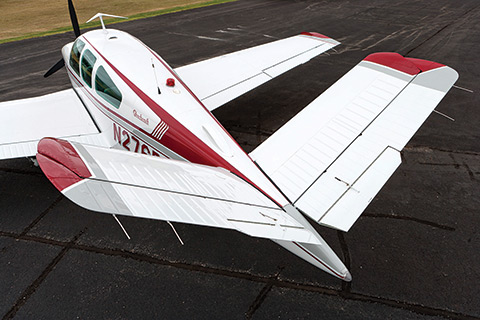
Independent studies in the 1980s concluded that the V-tail sustained greater stresses during pitch and yaw maneuvers, and did indeed have a higher accident rate than straight-tail models, and the American Bonanza Society disagreed with those findings at the time. ABS now acknowledges the accident rate was higher in V-tails but says that compliance with the AD requirements appears to negate the difference.
The V-tail Bonanza first flew in December 1945 and started its production run in 1947 at a price of $7,975. Production continued for 35 years. What are the chances you could not only find one but afford one? Excellent, if the used aircraft guide Trade A Plane is any indicator. There are usually 100 listed, and the majority are 1964 or newer models.
You may not be able to repeat the luck of Pat Smith, but you’ll have lots of speed and utility at a reasonable price.
E-mail the author at [email protected].


